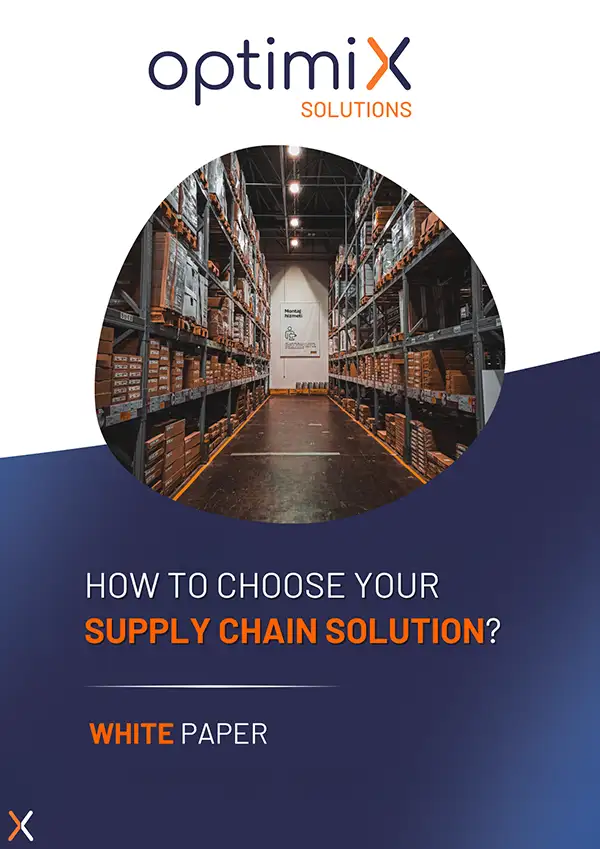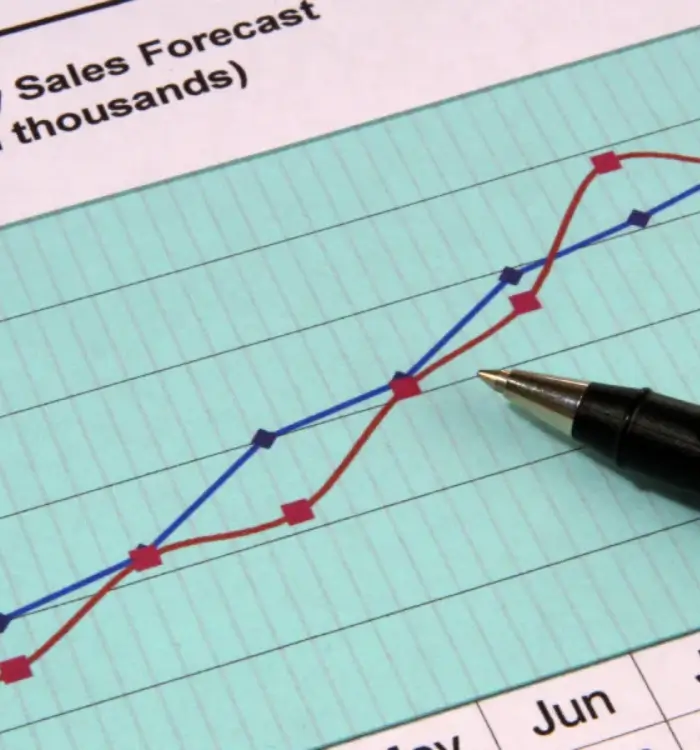Sales forecasting is the central pillar of any replenishment strategy . efficient. It enables anticipate stock requirements, avoid shortages and limit surpluses.
By providing a realistic estimate of future demand, it feeds into production, logistics, cash flow and human resources planning .. For networked companies, such as franchises, it can also be used to calibrate internal orders, as when a franchised site places an order with a central office, as Buffalo Grill does.
In a world where data is at the heart of decision-making, forecasting is becoming a key lever, integrated into management modules, dashboards, or even sales forecasting software increasingly used by VSEs and SMEs.
What is sales forecasting?
Sales forecasting is the quantitative and qualitative estimation of the volumes a company expects to sell over a given period.
It can apply to final sales as well as to internal demand, as in the case of franchisees who place orders with a head office.
It is a strategic process, often integrated into an information system or business management software. Forecasting thus becomes an operational tool for decisions relating to inventory management, purchasing, logistics and accounting.
Sales forecasting: why is it important?
Are you still wondering why sales forecasts are important ? You need to know that companies that control their inventories without forecasts navigate by sight. Without In anticipating demand, the risks are numerous: shortages, overstocking, obsolescence, cash flow pressures .
A good forecast makes it possible to project required volumes, secure replenishments and maintain optimal stock levels . This approach is often integrated into sales management software, ERP or ERP packages, to automate threshold alerts, streamline orders and manage indicators from a centralized dashboard.
It also meets the challenges of traceability, reporting and budget management, in a multi-product or multi-site context.
What's the difference between sales forecasting and demand forecasting?
Although these 2 notions are quite similar, there is a real a real difference between sales forecasting and demand forecasting. The sales forecasting is essentially based on the analysis ofsales historywith projections based on past behavior.
Demand forecasting, on the other hand, goes a step further: it aims to estimate the real market need, taking into account missed sales, the effects of advertising, promotions or other external events.
In other words, sales forecasting is company-oriented , while demand forecasting is market-oriented. In the most advanced management solutions, these two approaches are combined to provide a comprehensive view, particularly relevant in omnichannel environments .
The different tools for sales forecasting
Numerous sales forecasting tools on the market. Very small companies often rely on spreadsheets like Excel, but as soon as a certain volume is reached, it becomes essential to switch to management software software.
Among them, solutions such as Sage, EBP, Cegid or cloud platforms enable forecasting modules to be integrated directly into operational workflows.
This SaaS software automates data collection, exports analyses in the form of dashboards, and integrates the results into accounting software or inventory management tools.. Some even integrate the customer relationship management to refine sales projections.
With this in mind, Optimix’s XPA solution solution stands out for its ability to automatically cross-reference sales, logistics and contextual data to produce dynamic, flexible forecasts that can be directly activated in business processes.
Sales forecasts: Why isn't Excel enough?
Excel remains a widely-used tool for managing sales forecasts, not least because of its ease of use and flexibility. However, given the increasing volume of data, the complexity of the variables to be taken into account (seasonality, promotions, customer behavior…) and the need to work collaboratively and in real time, its limitations quickly become apparent. The risk of manual error, the lack of traceability, the absence of automation and the impossibility of integrating complex predictive models make it a tool ill-suited to today’s challenges. To understand in detail why it’s essential to go beyond Excel in your forecasting processes, read our full article : Sales forecasting: Why is a tool like Excel insufficient?.
How do you make a sales forecast?
Collecting historical data An essential starting point for any forecasting model.
Structuring and cleansing data Identify major trends, seasonal peaks and possible anomalies.
Select key products or segments Focus analysis on strategic or highly volatile references.
Integrate influential variables Include marketing events, weather effects, public holidays, promotions or other external factors.
Choose the right forecasting method Choose the right forecasting method: according to data type, time horizon and business needs.
Creating multiple scenarios Building optimistic, realistic and pessimistic projections to strengthen resilience.
Integrate scenarios into software modules Automate forecast updates using configurable tools.
Regular monitoring : compare forecasts with actual sales and adjust models on an ongoing basis
The different methods of effective sales forecasting
To obtain reliable sales forecasts, it’s not enough to rely on intuition or past trends observed with the naked eye. It’s essential to combine different methods – qualitative, quantitative and hybrid – to integrate historical data, market signals and field expertise.
Each approach has its advantages and limitations, and the choice of method depends on the context, the volume of data available and the company’s objectives. A well-thought-out forecasting strategy makes it possible to better manage inventories, anticipate peaks in activity and adjust resources more finely. To find out more about the different methods of effective sales forecasting, read our dedicated article : Methods for effective sales forecasts.
How to choose your sales forecasting software?
Choosing sales forecasting software isn’t just about comparing features: it’s also about finding the right solution for your processes, data volume and industry.and your industry.
For VSEs and SMEs, an intuitive tool in SaaS modeconnected to your ERP or CRM, is often ideal. It should automate data collection, produce reliable forecasts and provide clear dashboards.
The ability to integrate external variables (weather, promotions, seasonality) and manage multiple scenarios is essential to adjust your decisions in real time. For more complex businesses, software incorporating statistical or artificial intelligence models (XG Boost, neural networks) brings decisive value.
Finally, the personalizationErgonomics and ease of parameterization are crucial to encourage team buy-in. A good forecasting tool is a real lever for collaborative steering and performance.
Which KPIs to use to monitor sales forecasts?
The main indicators to follow in sales forecasting are the accuracy rate, expressed as a percentage of absolute error, and the forecast bias, which reflects the tendency to over- or under-estimate demand.
Other key KPIs include breakage rateservice service rateservice stock rotation as well as the overall impact on cash flow. When integrated into a A high-performance management tool, these indicators feed collaborative dashboards that can be customized and consulted in real time, facilitating precise, responsive business management.
Common sales forecasting errors
One of the most common errors in sales forecasting isoverlooking external factors such as weather, promotions or exceptional events, which can distort projections.
L’he use of a single model for all products is also problematic, as it does not take into account the specific features of each reference. L’ The failure to take account of feedback from the field, which is invaluable for adjusting forecasts, also undermines the reliability of the process.
Finally, a poor choice of software or parameterization of the forecasting modules modules can generate significant deviations, compromising the quality quality of analysis and the resulting operational decisions.
Highly accurate sales predictions thanks to AI
Artificial intelligence now makes it possible to significantly reduce the uncertainty associated with sales forecasts. Relying on advanced predictive models, companies can refine their scenarios, fine-tune inventories and reduce working capital requirements.
Integrating these algorithms into management software, whether specialized or part of an ERP system, automates the entire process, from data collection to decision-making.
This gain in precision improves overall company performance, whatever the sector of activity: trade, project management or e-commerce. Read our article on the subject here
In conclusion, sales forecasting is not just about estimating sales, but also about better managing inventory, securing supplies, optimizing cash flow and anticipating needs.
In a digital environment dominated by SaaS solutions solutions and ERPforecasting tools integrate directly with sales management softwareand accounting software or decision-making dashboards.
For VSEs and SMEssolutions like Optimix XPA offer real time savings, greater visibility and the ability to react more quickly to market trends. Forecasting thus becomes an essential asset for effective business management.








